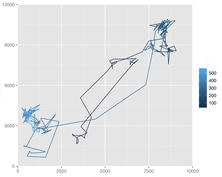Publication trimestrielle du Laboratoire
d'analyse et d'architecture des systèmes du CNRS
Humanoid robotics is coming of age with faster and more agile robots. To keep up with mechanical complexity, research has begun to look beyond the usual robotics approach, to life sciences, in order to better organize humanoid motion. This thesis explores the anthropological link between the structure of a human and that of a humanoid robot. First, by using conventional robotics methods like optimal control, we understand the principles behind repetitive human movements like yoyo playing. We then shift our focus to locomotion and take inspiration from human neuroscience research on the role of the head in human walking. By allowing a user to control the head of a humanoid, we develop a control method to generate deliberative whole-body humanoid motion including stepping, purely as a consequence of the head movement. This idea is extended in the final study by studying goal directed locomotion in humans, and extracting the characteristics of this motion as invariants. By drawing a link between "invariants" in neuroscience and "kinematic tasks" in humanoid robotics, we develop a method to generate realistic goal directed locomotion for other anthropomorphic figures. In this case the results are illustrated on the humanoid robot HRP-2.





